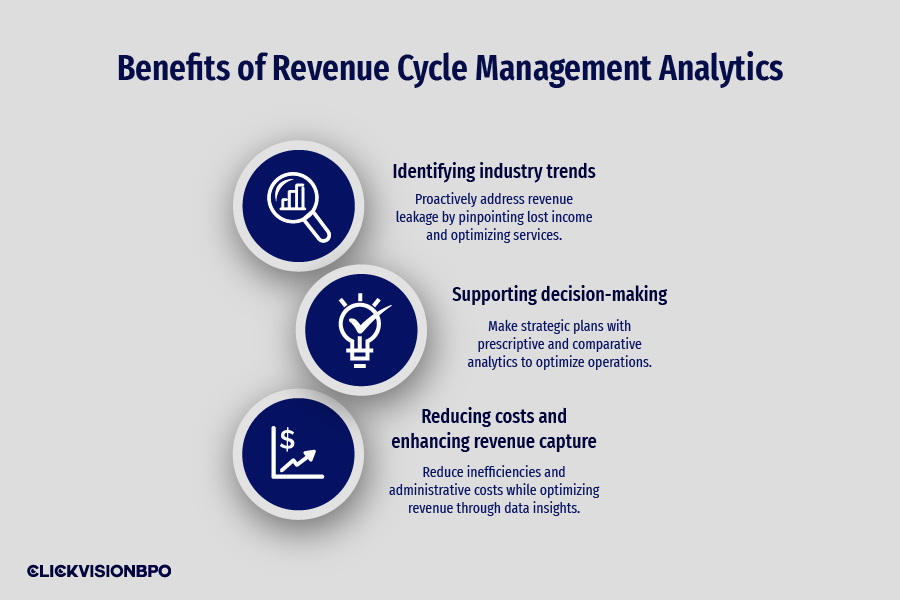Healthcare providers face numerous challenges in optimizing their revenue cycle management (RCM) operations, from navigating complex billing and coding procedures to adapting to ever-evolving regulatory requirements. These complexities can significantly impact the financial health of health organizations, leading to revenue leakage and processing inefficiencies. However, revenue cycle analytics emerge as invaluable tools in overcoming these obstacles, making them paramount within administrative sectors. But what is the role of revenue cycle analytics in healthcare?
Below, you’ll learn everything about revenue cycle analytics and its indispensable role in optimizing financial performance and revenue capture within the healthcare domain!
Understanding Revenue Cycle Analytics
Revenue cycle analytics is a data-driven approach that has revolutionized revenue generation and operational efficiency within the healthcare industry and medical finance sectors. By optimizing and streamlining revenue procedures, this methodology involves meticulously collecting, analyzing, and interpreting financial and operational data points across the entire revenue cycle. From initial patient registration to the final payment collection, every step of cycle analytics is scrutinized for opportunities to enhance organizational performance.
However, this approach isn’t only valuable for processing and analyzing numbers; it also serves as a critical tool for optimizing revenue streams and refining operational processes within the administrative sector in healthcare institutions. Thus, delving into the metrics and indicators and incorporating the best practices for revenue cycle analytics can gain you invaluable insights, crucial for improvement.

Source: freepik.com / Photo Contributor: freepic.diller
Benefits of Revenue Cycle Management Analytics
Revenue cycle management analytics offer manifold advantages, drastically improving the financial health of a medical organization by streamlining operations, increasing patient satisfaction, and enhancing financial performance. Some of the key benefits of analytics include:
Identifying industry trends
Identifying industry trends within financial data enables organizations to take proactive measures to address revenue leakage and optimize revenue generation processes. By pinpointing sources of lost income, detecting payment patterns, and analyzing patient behavior, organizations can tailor their services and optimize their performance. Additionally, analytics allow tracking reimbursement rates and claim denials, allowing your clinic to mitigate risks of inefficiencies or compliance issues.
Supporting decision-making
Supporting decision-making by providing insights through prescriptive and comparative analytics allows organizations to optimize operations and make informed and strategic plans. Whether this entails negotiating with insurance companies or investing in advanced technologies, revenue cycle analytics significantly improves revenue cycle management.
Reducing costs and enhancing revenue capture
Revenue cycle analytics helps reduce costs by enabling your organization to promptly address inefficiencies like claim denials or delayed payments. This can result in streamlined operations and expedited revenue cycle processes, ultimately reducing administrative costs and enhancing financial sustainability and performance.
Enhance revenue capture by leveraging data insights and uncovering opportunities through predictive analytics. This allows you to proactively optimize revenue generation and minimize revenue leakage throughout the entire cycle.

Key Metrics and Indicators
To thoroughly understand the role of revenue cycle analytics in healthcare, you’d also require familiarity with the key metrics and indicators within this sector. Delving into these metrics is critical for optimizing financial performance and operational efficiency, hence our quick elaboration on each indicator to help you utilize them and leverage their insights effectively.
- Accounts receivable (AR) days represent the average number of days it takes your company to collect payments from customers after services are rendered. While a high number of accounts receivable days indicates delays in payments, low numbers signify faster collections, evidencing fast cash flow and optimal financial performance.
- Denial rates measure the percentage of claims denied or rejected by third-party payers, helping you identify areas for improvement in claim submission, coding accuracy, and payer communication to ensure maximum revenue capture.
- Clean claim rates represent the percentage of claims that are successfully processed and paid by third-party insurers on the first submission without encountering any errors, delays, or inquiries.
- Collections rates provide valuable insights into the revenue collection efforts, payment realization, and billing efficiency, focusing specifically on revenue collected for services rendered.
Data Sources for Revenue Cycle Analytics
As the healthcare administrative sector evolves, the need for integrating data from disparate systems becomes increasingly crucial to drive informed decision-making and optimizing operational processes. However, accessing accurate, reliable, and timely information from various sources could be a challenge for many organizations.
With the proliferation of electronic health records (EHR), billing systems, and financial reports, there’s a wealth of internal data sources available for analysis, streamlining operations, and providing a more comprehensive view of the revenue cycle. Moreover, external data sources such as payer data and industry benchmarks also play a significant role in providing invaluable and comparative analysis data for healthcare organizations, helping them optimize RCM strategies.
Predictive Analytics in Revenue Cycle Management
Predictive analytics play a vital role in revenue cycle management by utilizing data-driven insights to forecast future revenue trends and optimize revenue cycle processes. By leveraging predictive models, healthcare organizations can anticipate industry trends, allowing them to adapt and tailor their strategies proactively and maximize revenue capture.
Moreover, predictive analytics also enable the identification and prediction of claim denials, enabling organizations to take preemptive action, minimize revenue loss, and streamline reimbursement processes. This innovative and multifaceted approach allows providers to make informed decisions and improve financial performance and stability while also enhancing operational efficiency within the revenue cycle.
Revenue Cycle Optimization Strategies
Revenue cycle optimization strategies using analytics are essential for healthcare organizations seeking to enhance financial performance and operational efficiency. However, this entails implementing strategic approaches to streamline workflows, improve coding accuracy, reduce denials, and enhance patient collections.
Streamlining workflows involves leveraging revenue analytics to identify inefficiencies within the revenue cycle process, allowing you to detect areas for improvement and improve overall efficiency. Adding automation tools can further resolve this process, helping you reduce manual intervention and increase the speed and accuracy of revenue cycle tasks.
Furthermore, data analytics also play a critical role in improving coding accuracy, which is essential for maximizing revenue capture, reducing denials or delays, and enhancing overall patient collections. By analyzing trends and patterns and identifying frequent coding errors, organizations can provide targeted and tailored solutions to reduce inefficiencies and ensure accurate coding.
With ongoing monitoring and analysis metrics, your clinic can improve and continually refine its back-office operations, streamlining efficient workflow and maintaining high levels of accuracy and excellence.

Source: freepik.com / Photo Contributor: creativeart
Conclusion
In conclusion, revenue cycle analytics is highly recognized as a critical component of a healthcare organization’s financial health and performance. It represents a data-driven approach that has revolutionized revenue generation, providing valuable insights for managing patient revenue from appointment scheduling to payment collection.
Leveraging data analytics is the key to unlocking the full potential of your organization’s insightful data analysis, helping you drive and ensure optimal revenue capture while maintaining excellent financial performance and operational efficiency.
We, at CLICKVISION BPO offer comprehensive RCM solutions by utilizing advanced analytics and technology to streamline workflows, improve coding accuracy, and reduce denials while enhancing patient collections. The key metrics help you navigate the complexities and intricacies of RCM, guiding you in identifying areas of improvement, tracking key performance indicators, and measuring the effectiveness of revenue cycle strategies.

With a strong background in the marketing industry and healthcare leadership roles, Filip is responsible for CLICKVISIONBPO’s sales strategies and onboarding new clients. With a passion for sharing insights gained from his experience, he also shares valuable knowledge through industry related articles.
